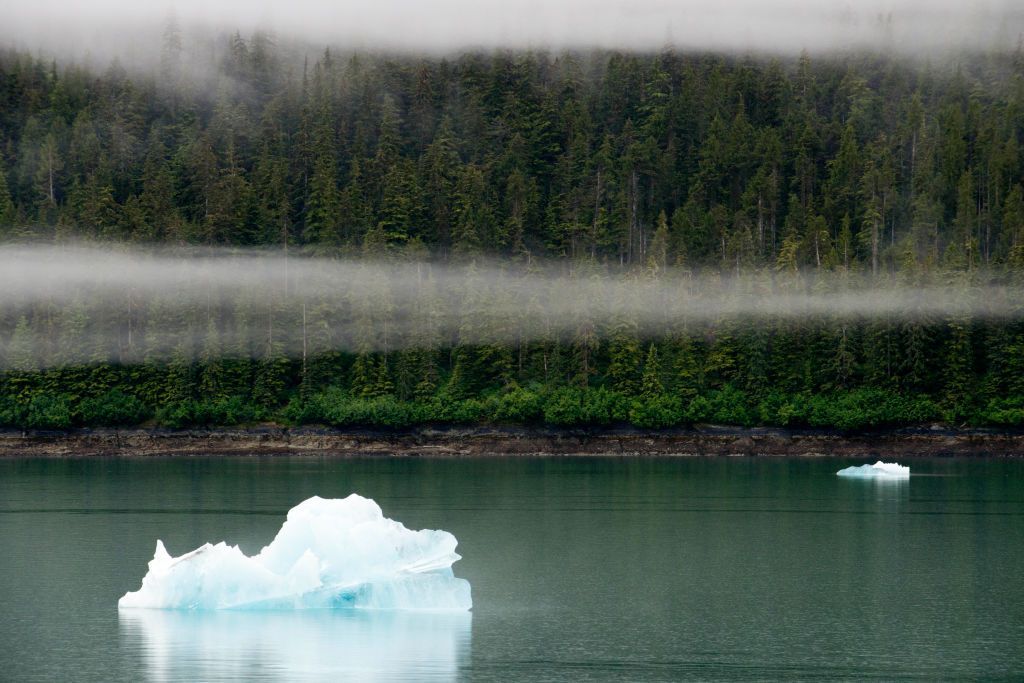Trump Moves to Allow Logging in the World’s Largest Intact Temperate Rainforest
ENVIRONMENT, ANGLO AMERICA, 2 Sep 2019
Kyla Mandel | Think Progress – TRANSCEND Media Service
Meanwhile, the Amazon burns.

Icebergs near the Dawes Glacier, Endicott Arm, Tongass National Forest, Alaska, USA.
(Sergi Reboredo/VW PICS/Universal Images Group via Getty Images)
28 Aug 2019 – As Brazil’s Amazon burns, President Donald Trump is taking aim at one of the largest expanses of temperate rainforest in Alaska.
Yesterday, the president instructed Agriculture Secretary Sonny Perdue to allow logging in the 16.7 million acre Tongass National Forest in Southeast Alaska, the nation’s largest national forest.
Together with British Columbia’s Great Bear Rainforest in Canada, the Tongass encompasses the largest intact temperate rainforest on Earth.
The move would undo logging restrictions that have been in place for nearly 20 years, according to The Washington Post, impacting more than half of the national forest.
Under the Clinton-era “roadless rule,” construction of roads were barred in the forest, thereby restricting commercial logging, energy, and mining projects (only certain road projects approved by the Forest Service were allowed).
The rule has faced challenges over the years, though, including by President George W. Bush who tried unsuccessfully to reverse it. Alaska Gov. Mike Dunleavy (R) and Sen. Lisa Murkowski (R) have also called for Trump to exempt the state from the rule.
“It should never have been applied to our state, and it is harming our ability to develop a sustainable, year-round economy for the Southeast region,” Murkowski said in a statement to the Washington Post.
The old-growth trees of the Tongass National Forest provide a MAJOR BUFFER against climate change.https://t.co/wW5bGGhBnK
— Earthjustice (@Earthjustice) August 25, 2019
Environmentalists, however, fear the implications of opening up the rainforest to commercial activities.
The pristine forest includes thousands of islands along with glacial fjords and old-growth cedar, spruce, and hemlock trees — old-growth trees are those that have generally grown undisturbed for at least 120 years. The area supports countless wildlife, including all five species of Pacific salmon, brown bears, wolves, and Bald Eagles.
Over the years, logging has threatened the oldest — and largest — trees. But while only 9% of the rare forest has so far been threatened by logging, according to the Audubon Society “perhaps half of the big-tree old growth has been cut.”
The forest is also a vital player in tackling climate change.
“The Tongass stores hundreds of millions, if not over a billion, tons of carbon, keeping the heat-trapping element out of the atmosphere,” wrote Earthjustice, which tweeted that the old-growth trees provide a “MAJOR BUFFER” against climate change.
Cutting down ancient trees risks not just releasing the carbon stored in them over the past century but also reducing the forest’s ability to store new carbon.
News of the Trump administration’s logging intentions in Tongass come as another major forest suffers devastating wildfires. In Brazil, more than 26,000 forest fires have been recorded in the Amazon this month — the most in a decade.
Like the Tongass, the Amazon — often referred to as the “lungs” of the planet — plays a vital role in storing carbon as well as critical habitat to endangered species.
__________________________________________________
 Kyla Mandel is the editor for the climate team. Her work has appeared in National Geographic, Mother Jones, and Vice. She has a master’s degree from Columbia University’s Graduate School of Journalism, specializing in science, health, and environment reporting. You can reach her at kmandel@thinkprogress.org.
Kyla Mandel is the editor for the climate team. Her work has appeared in National Geographic, Mother Jones, and Vice. She has a master’s degree from Columbia University’s Graduate School of Journalism, specializing in science, health, and environment reporting. You can reach her at kmandel@thinkprogress.org.
Go to Original – thinkprogress.org
Tags: Conflict, Deforestation, Environment, Trump, USA, Violence
DISCLAIMER: The statements, views and opinions expressed in pieces republished here are solely those of the authors and do not necessarily represent those of TMS. In accordance with title 17 U.S.C. section 107, this material is distributed without profit to those who have expressed a prior interest in receiving the included information for research and educational purposes. TMS has no affiliation whatsoever with the originator of this article nor is TMS endorsed or sponsored by the originator. “GO TO ORIGINAL” links are provided as a convenience to our readers and allow for verification of authenticity. However, as originating pages are often updated by their originating host sites, the versions posted may not match the versions our readers view when clicking the “GO TO ORIGINAL” links. This site contains copyrighted material the use of which has not always been specifically authorized by the copyright owner. We are making such material available in our efforts to advance understanding of environmental, political, human rights, economic, democracy, scientific, and social justice issues, etc. We believe this constitutes a ‘fair use’ of any such copyrighted material as provided for in section 107 of the US Copyright Law. In accordance with Title 17 U.S.C. Section 107, the material on this site is distributed without profit to those who have expressed a prior interest in receiving the included information for research and educational purposes. For more information go to: http://www.law.cornell.edu/uscode/17/107.shtml. If you wish to use copyrighted material from this site for purposes of your own that go beyond ‘fair use’, you must obtain permission from the copyright owner.
Read more
Click here to go to the current weekly digest or pick another article:
ENVIRONMENT:
- COP30’s Three F-Words: Failure on Fossil Fuels
- Declaration of the Peoples’ Summit Towards COP30
- Plutonium Found at Former San Francisco Naval Shipyard – Navy Faces Cover-Up Claims
ANGLO AMERICA: